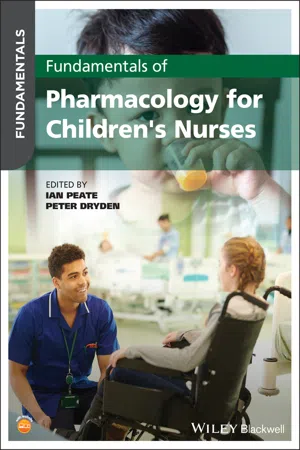
Fundamentals of Pharmacology for Children's Nurses
- English
- ePUB (mobile friendly)
- Available on iOS & Android
Fundamentals of Pharmacology for Children's Nurses
About this book
Registered Nurses must have thorough knowledge of pharmacology, medicines administration, and the effects of medicines. Fundamentals of Pharmacology for Children's Nurses is written for nurses and allied health professionals involved in the care of children and young people (CYP) to focus exclusively on pharmacology. Filling a gap in current literature on the subject, this much-needed resource develops the competence and confidence required to prescribe, dispense, and administer medicines to children and young people.
Emphasising the importance of patient-centered care to CYP, the text describes the role of the healthcare provider working with CYP and their families; explains how to use pharmaceutical and prescribing reference guides; discusses legal and ethical issues; examines pharmacodynamics and pharmacokinetics, and more. Helping readers respond appropriately and compassionately to the needs of those receiving care and their families, this textbook:
- Covers a wide range of medications used in diabetes, cancer, mental health, and other areas
- Features a wealth of full-colour images and numerous pedagogical tools including learning objectives, self-test questions, and reflective exercises to enable readers to contextualise and assess their knowledge
- Presents case studies to reinforce learning, and illustrate the application of theory to practice
- Provides authoritative and practical guidance on formulations, adverse drug reactions, analgesics, antibiotics, immunisations, and the medications most commonly used when providing care to CYP
- Includes access to a companion website with interactive MCQs, case studies, references, an image bank, and links to further reading and supplemental resources
Fundamentals of Pharmacology for Children's Nurses is essential reading for undergraduate children's nursing students, trainee nursing associates, those undertaking healthcare programmes of study, as well as those seeking to better understand pharmacology.
Frequently asked questions
- Essential is ideal for learners and professionals who enjoy exploring a wide range of subjects. Access the Essential Library with 800,000+ trusted titles and best-sellers across business, personal growth, and the humanities. Includes unlimited reading time and Standard Read Aloud voice.
- Complete: Perfect for advanced learners and researchers needing full, unrestricted access. Unlock 1.4M+ books across hundreds of subjects, including academic and specialized titles. The Complete Plan also includes advanced features like Premium Read Aloud and Research Assistant.
Please note we cannot support devices running on iOS 13 and Android 7 or earlier. Learn more about using the app.
Information
1
Introduction to Pharmacology, Children and Young People
Aim
Learning Outcomes
- Understand the importance of following policies and the issues associated with medicine management
- Recognise the legal frameworks and NMC code within this important aspect of care
- Increase knowledge and understanding of pharmacological principles associated with the child, young person and their family
- Appreciate the importance of the role of the family/carer and family‐centred care
Test Your Knowledge
- What is your role in medicine management?
- What are the five principles of medication administration?
- What is the difference between the terms ‘drug’ and ‘medicine’?
- Describe family‐centred care and its importance in your practice?
- What does medicine optimisation mean?
| PHARMACOKINETICS | PHARMACODYNAMICS |
|---|---|
| absorption | molecular |
| distribution | biochemical |
| metabolism | physiological effects of drugs on the body |
| excretion of drugs in the body |
Introduction to Pharmacology
Professional Framework
- Prioritise people
- Practise effectively
- Preserve safety
- Promote professionalism and trust
Advise on, prescribe, supply, dispense or administer medicines within the limits of your training and competence, the law, our guidance and other relevant policies, guidance and regulations.NMC, 2018a – see Table 1.2
To preserve safety in relation to medicine administration, you must: 18.1 Prescribe, advise on, or provide medicines or treatment, including repeat prescriptions (only if you are suitably qualified) if you have enough knowledge of that person’s health and are satisfied that the medicines or treatment serve that person’s health needs 18.2 Keep to appropriate guidelines when giving advice on using controlled drugs and recording the prescribing, supply, dispensing or administration of controlled drugs 18.3 Make sure that the care or treatment you advise on, prescribe, supply, dispense or administer for each person is compatible with any other care or treatment they are receiving, including (where possible) over the counter medicines 18.4 Take all steps to keep medicines stored securely 18.5 Wherever possible, avoid prescribing for yourself or for anyone with whom you have a close personal relationship Source: NMC (2018a). This extract is reproduced and reprinted with permission with th...
Table of contents
- Cover
- Table of Contents
- Title Page
- Copyright Page
- Dedication Page
- Contributors
- Preface
- Acknowledgements
- Prefixes and Suffixes
- Abbreviations
- About the Companion Website
- 1 Introduction to Pharmacology, Children and Young People
- 2 How to Use Pharmaceutical and Prescribing Reference Guides
- 3 Legal and Ethical Issues
- 4 Medicines Management and the Role of the Healthcare Provider Working with Children, Young People and Families
- 5 Pharmacodynamics and Pharmacokinetics
- 6 Drug Formulations
- 7 Medications Used in the Cardiovascular System
- 8 Medications Used in theRenal System
- 9 Medications Used in the Endocrine System
- 10 Medications Used in the Respiratory System
- 11 Medications Used in the Gastrointestinal System
- 12 Medications Used in the Nervous System
- 13 The Immune System and Immunisations
- 14 Medications and the Integumentary System
- 15 Medications Used in Children and Young People’s Mental Health
- 16 Medications Used in Children and Young People’s cancer
- 17 Analgesics
- 18 Antimicrobial Medications
- 19 Adverse Drug Reactions
- Answers
- Index
- End User License Agreement